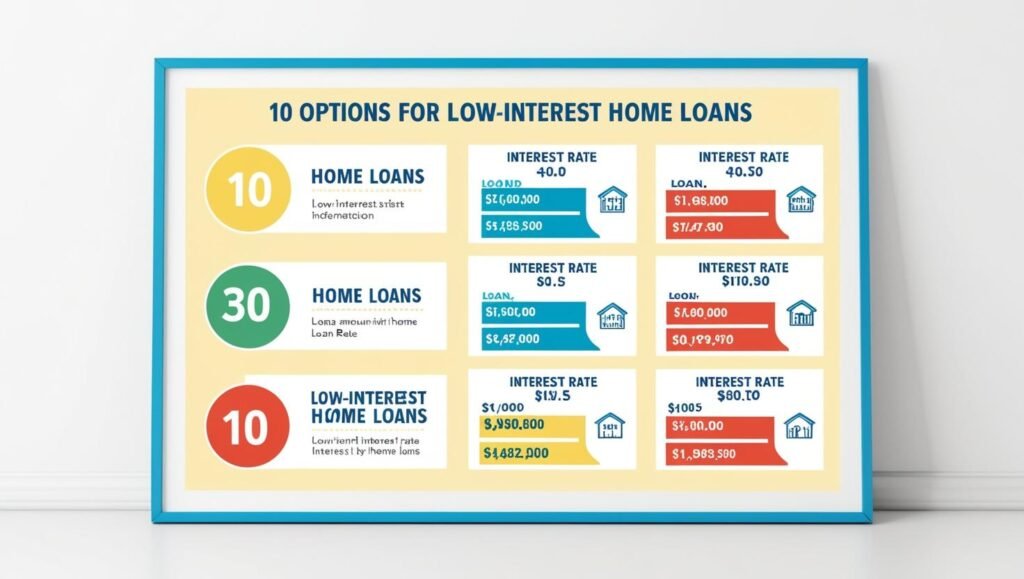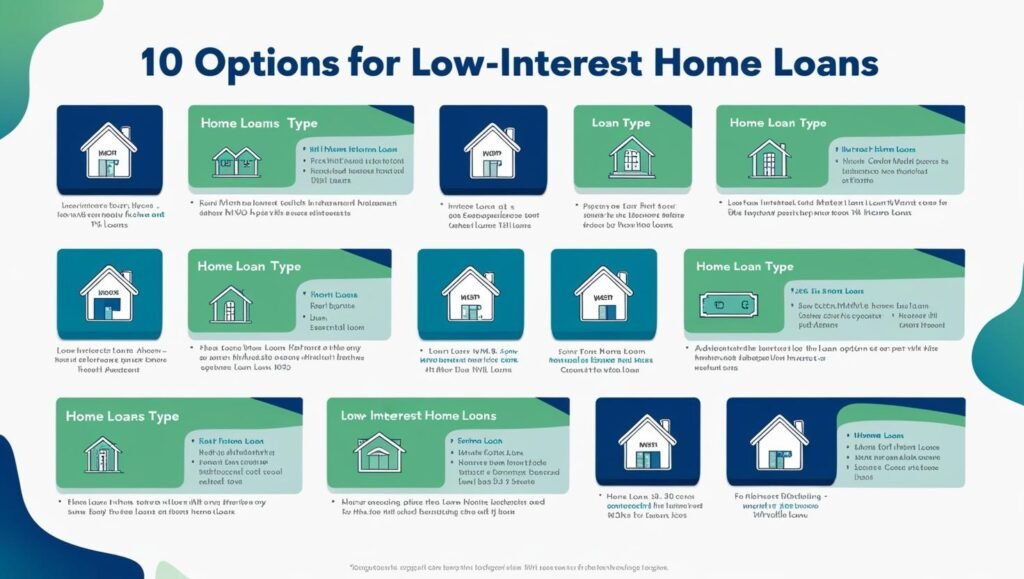When it comes to homeownership, the ability to secure affordable financing can significantly impact your long-term financial health. Low-interest loans are especially valuable because they allow homeowners to borrow money at a lower cost, ultimately saving them a considerable amount of money over time. Whether you need a loan for home improvements, debt consolidation, or an emergency expense, understanding your options can help you make informed decisions.

In this article, we’ll explore the top 10 low-interest loans for homeowners, helping you navigate your choices for the most competitive financing options available.
1. What Is a Low-Interest Loan?
A low-interest loan is a type of loan that charges a relatively small percentage in interest compared to other loans. The interest rate is the cost of borrowing money, expressed as a percentage of the loan amount. Typically, the lower the interest rate, the less you will have to pay in interest over the life of the loan, making it more affordable for homeowners.
In most cases, low-interest loans come with terms that favor the borrower, such as longer repayment periods and fixed or adjustable rates. Homeowners looking for financial relief or to fund specific projects should consider these loans for their affordability and flexibility.
2. Why Should Homeowners Consider Low-Interest Loans?
Homeownership comes with its own set of financial responsibilities. From mortgage payments to property taxes, homeowners often find themselves juggling multiple financial obligations. By securing a low-interest loan, homeowners can benefit in several ways:
- Lower Monthly Payments: With a lower interest rate, homeowners can reduce their monthly payments, making it easier to manage cash flow.
- Reduced Total Interest: Over time, you pay less in interest, which means you’ll ultimately spend less money on the loan.
- Financial Flexibility: Low-interest loans provide flexibility to homeowners, allowing them to invest in home improvements, consolidate debts, or meet other financial needs.
- Improved Credit Score: Timely repayment of low-interest loans can also positively impact your credit score.
Given these advantages, low-interest loans are an appealing choice for homeowners who want to manage their finances efficiently.
3. Top 10 Low-Interest Loans for Homeowners
Now that we understand the importance of low-interest loans, let’s explore the top 10 options available to homeowners. Each of these loans offers competitive interest rates and favorable terms.
1. Home Equity Loans
A home equity loan is one of the most common and accessible low-interest options for homeowners. This type of loan allows you to borrow against the equity you’ve built up in your home. Home equity loans typically come with fixed interest rates, which means your payments remain consistent throughout the loan term. They are ideal for homeowners who need a lump sum of money for a specific project or expense.
Key Benefits:
- Low-interest rates, often between 3% and 8%
- Fixed repayment terms
- Use the loan for home improvements, debt consolidation, or large expenses
Considerations:

- Risk of foreclosure if you default, as the loan is secured by your home
2. Cash-Out Refinance
A cash-out refinance allows homeowners to refinance their mortgage for more than they owe, taking the difference in cash. This loan type typically comes with a lower interest rate than a standard home equity loan, making it an attractive option for homeowners seeking to take advantage of current interest rates.
Key Benefits:
- Lower interest rates than other forms of borrowing
- Can be used for home improvements, debt consolidation, or other expenses
- Refinance existing mortgage for better terms
Considerations:
- Increases your mortgage balance, which could result in higher monthly payments
- Requires you to have sufficient home equity
3. Personal Loans
While personal loans are unsecured and typically come with higher interest rates than secured loans, some personal loans offer competitive rates for homeowners with good credit scores. Personal loans can be used for various purposes, including home improvements, emergency expenses, or debt consolidation.
Key Benefits:
- No collateral required
- Quick approval process
- Fixed repayment terms
Considerations:
- Higher interest rates compared to home equity loans or refinancing
- May require excellent credit to qualify for low rates
4. Federal Housing Administration (FHA) Loans
FHA loans are government-backed loans designed for low- to moderate-income borrowers. These loans offer lower interest rates and lower down payment requirements than conventional mortgages, making them an attractive option for first-time homeowners or those who have less-than-perfect credit.
Key Benefits:
- Lower interest rates compared to conventional loans
- Lower down payment requirements (as low as 3.5%)
- Easier to qualify for with less-than-perfect credit
Considerations:
- Requires mortgage insurance premiums (MIP) for the life of the loan
- Limited to primary residences
5. Veterans Affairs (VA) Loans
VA loans are available to military veterans, active-duty service members, and certain members of the National Guard and Reserves. These loans offer low or no down payment requirements and competitive interest rates. VA loans also don’t require private mortgage insurance (PMI), which can save homeowners money in the long term.
Key Benefits:
- Low-interest rates
- No down payment required
- No PMI required
Considerations:
- Available only to eligible veterans and service members
6. Home Improvement Loans
If you’re looking to finance home improvements, a home improvement loan may be an excellent option. These loans are typically offered by banks, credit unions, or other lenders and are specifically designed for homeowners who want to make repairs, remodel, or upgrade their homes.
Key Benefits:
- Low-interest rates for home improvement purposes
- Fixed repayment terms
- Increases the value of your home
Considerations:
- May require collateral
- Funds are typically released in installments
7. HELOC (Home Equity Line of Credit)
A HELOC is another loan option that allows homeowners to borrow against their home’s equity. Unlike a home equity loan, which provides a lump sum, a HELOC gives you access to a line of credit that you can draw from as needed. This makes it a flexible option for homeowners who may need to access funds over time.
Key Benefits:
- Lower interest rates compared to credit cards or personal loans
- Flexible borrowing options
- Interest-only payments during the draw period
Considerations:
- Variable interest rates, which may rise over time
- Risk of foreclosure if you default
8. Fixed-Rate Mortgages

A fixed-rate mortgage is a popular option for homeowners who are looking for stability in their monthly payments. The interest rate remains the same throughout the life of the loan, making it easier to budget and plan for the future. This is ideal for homeowners who want predictable payments.
Key Benefits:
- Consistent interest rates throughout the loan term
- Stability in monthly payments
- Can be used for purchasing or refinancing a home
Considerations:
- Typically higher interest rates than adjustable-rate mortgages (ARMs)
9. Adjustable-Rate Mortgages (ARMs)
An adjustable-rate mortgage (ARM) offers a lower initial interest rate compared to fixed-rate mortgages. However, the rate is subject to change after a specified period, which means that your monthly payments can fluctuate. ARMs are suitable for homeowners who expect to sell or refinance before the rate adjusts.
Key Benefits:
- Lower initial interest rates
- Ideal for homeowners planning to move or refinance within a few years
Considerations:
- Interest rates may increase, leading to higher monthly payments
- Potential for payment shock
10. Community Development Loans
Some communities offer low-interest loans to homeowners who meet certain eligibility requirements. These loans are often provided by nonprofit organizations or government programs aimed at promoting homeownership and community development.
Key Benefits:
- Very low-interest rates, sometimes as low as 1%
- Available for homebuyers or homeowners looking to make improvements
- Often part of local government initiatives
Considerations:
- May have strict eligibility requirements
- Loan amounts may be limited
4. Things to Consider Before Taking a Loan
Before committing to any loan, it’s crucial to carefully evaluate your financial situation. Here are some factors to keep in mind:
- Interest Rates: Always compare the interest rates of different loan options. A lower interest rate will save you money over time.
- Repayment Terms: Ensure that the loan’s repayment period fits within your budget and financial goals.
- Loan Fees: Watch out for hidden fees or charges, such as application fees, origination fees, or prepayment penalties.
- Eligibility Requirements: Some loans may have strict eligibility criteria, including minimum credit scores or income requirements.
- Risk of Foreclosure: For secured loans, like home equity loans and HELOCs, consider the risk of losing your home if you default on the loan.
5. Final Thoughts: Navigating the Best Loan for You
Choosing the right loan is a critical decision that can have long-term implications on your finances. Low-interest loans, whether for home improvement, debt consolidation, or other expenses, offer homeowners the opportunity to manage their finances more effectively. By understanding the options available to you and carefully considering the benefits and risks, you can make a decision that aligns with your financial goals and personal circumstances.
Frequently Asked Questions (FAQ)
1. What is the best low-interest loan for home improvements?
A home equity loan or a home improvement loan typically offers the best low-interest rates for home improvements. Both loans use your home’s value to secure the loan, providing you with a lower interest rate.
2. Can I qualify for a low-interest loan with bad credit?
It may